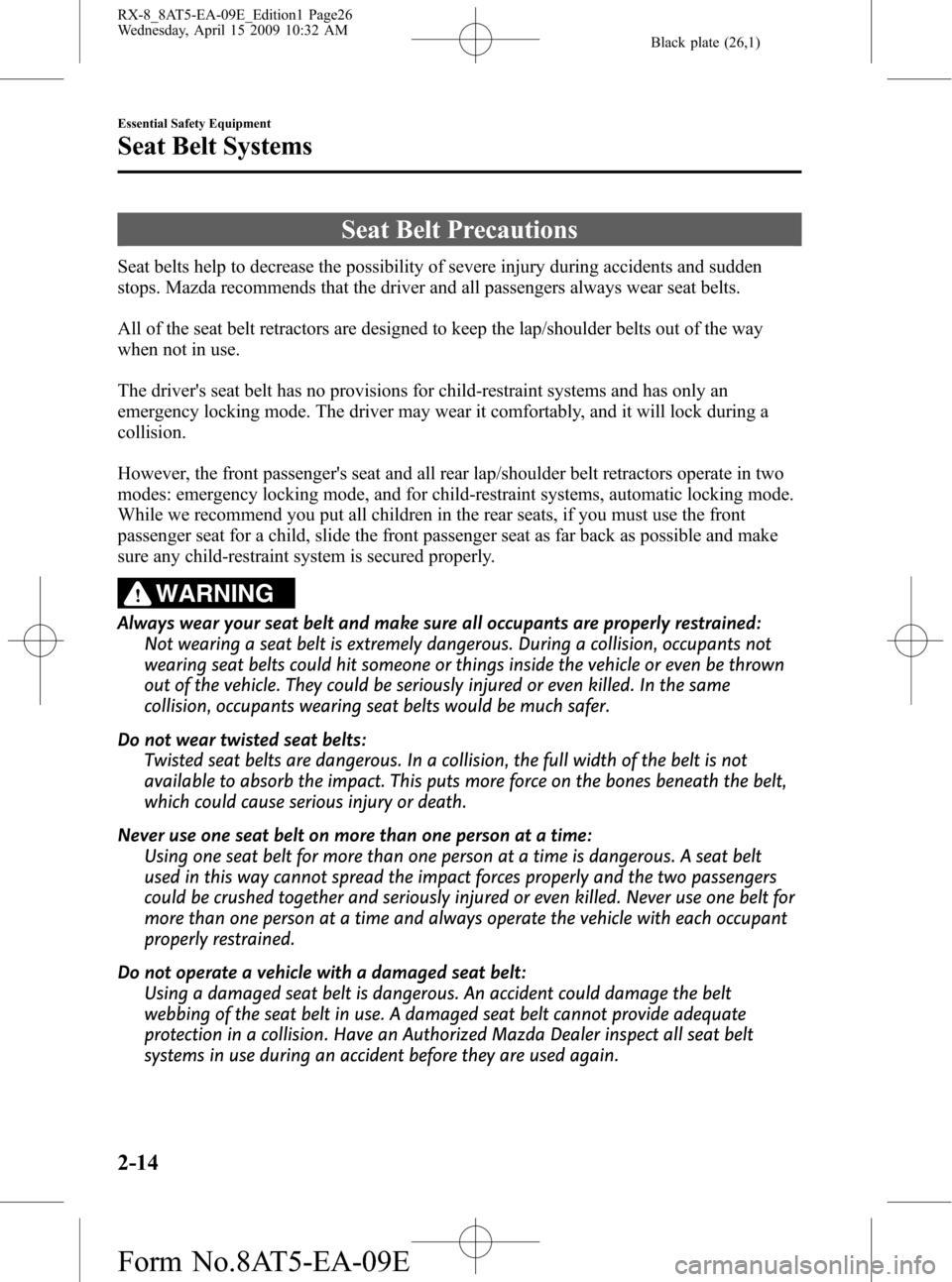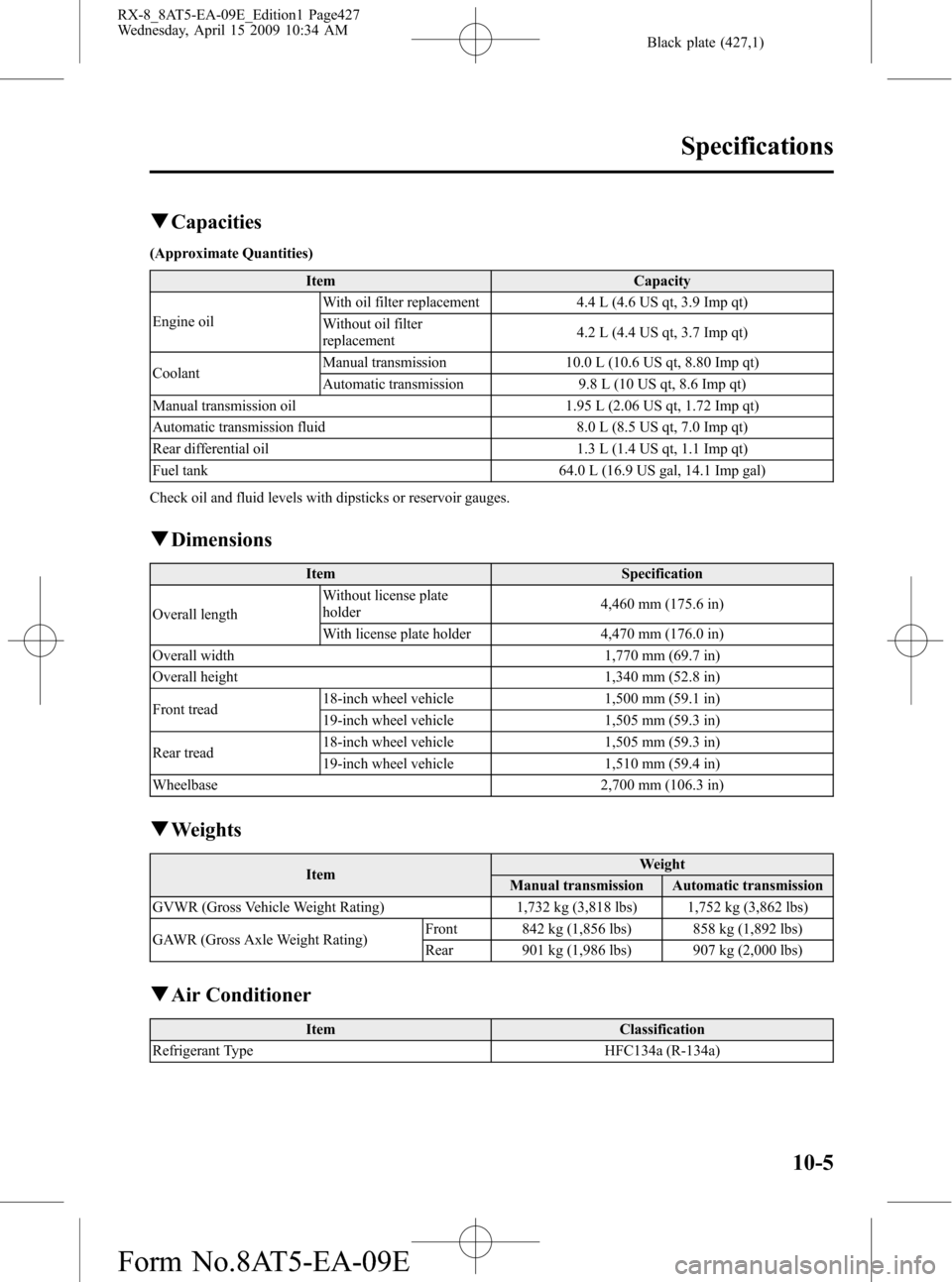width MAZDA MODEL RX 8 2010 Owners Manual (in English)
[x] Cancel search | Manufacturer: MAZDA, Model Year: 2010, Model line: MODEL RX 8, Model: MAZDA MODEL RX 8 2010Pages: 438, PDF Size: 7.02 MB
Page 26 of 438

Black plate (26,1)
Seat Belt Precautions
Seat belts help to decrease the possibility of severe injury during accidents and sudden
stops. Mazda recommends that the driver and all passengers always wear seat belts.
All of the seat belt retractors are designed to keep the lap/shoulder belts out of the way
when not in use.
The driver's seat belt has no provisions for child-restraint systems and has only an
emergency locking mode. The driver may wear it comfortably, and it will lock during a
collision.
However, the front passenger's seat and all rear lap/shoulder belt retractors operate in two
modes: emergency locking mode, and for child-restraint systems, automatic locking mode.
While we recommend you put all children in the rear seats, if you must use the front
passenger seat for a child, slide the front passenger seat as far back as possible and make
sure any child-restraint system is secured properly.
WARNING
Always wear your seat belt and make sure all occupants are properly restrained:
Not wearing a seat belt is extremely dangerous. During a collision, occupants not
wearing seat belts could hit someone or things inside the vehicle or even be thrown
out of the vehicle. They could be seriously injured or even killed. In the same
collision, occupants wearing seat belts would be much safer.
Do not wear twisted seat belts:
Twisted seat belts are dangerous. In a collision, the full width of the belt is not
available to absorb the impact. This puts more force on the bones beneath the belt,
which could cause serious injury or death.
Never use one seat belt on more than one person at a time:
Using one seat belt for more than one person at a time is dangerous. A seat belt
used in this way cannot spread the impact forces properly and the two passengers
could be crushed together and seriously injured or even killed. Never use one belt for
more than one person at a time and always operate the vehicle with each occupant
properly restrained.
Do not operate a vehicle with a damaged seat belt:
Using a damaged seat belt is dangerous. An accident could damage the belt
webbing of the seat belt in use. A damaged seat belt cannot provide adequate
protection in a collision. Have an Authorized Mazda Dealer inspect all seat belt
systems in use during an accident before they are used again.
2-14
Essential Safety Equipment
Seat Belt Systems
RX-8_8AT5-EA-09E_Edition1 Page26
Wednesday, April 15 2009 10:32 AM
Form No.8AT5-EA-09E
Page 357 of 438

Black plate (357,1)
CAUTION
ØA wrong-sized wheel may
adversely affect:
ØTire fit
ØWheel and bearing life
ØGround clearance
ØSnow-chain clearance
ØSpeedometer calibration
ØHeadlight aim
ØBumper height
ØTire Pressure Monitoring
System
ØLimited-Slip Differential System
Ø(With Tire Pressure Monitoring
System)
ØWhen replacing/repairing the
tires or wheels or both, have the
work done by an Authorized
Mazda Dealer, or the tire
pressure sensors may be
damaged.
ØThe wheels equipped on your
Mazda are specially designed
for installation of the tire
pressure sensors. Do not use
non-genuine wheels, otherwise
it may not be possible to install
the tire pressure sensors.
NOTE
Be sure to install the tire pressure sensors
whenever tires or wheels are replaced. Refer to
Tires and Wheels on page 5-33.
When replacing a wheel, make sure the
new one is the same as the original factory
wheel in diameter, rim width, and offset.
Proper tire balancing provides the best
riding comfort and helps reduce tread
wear. Out-of-balance tires can cause
vibration and uneven wear, such as
cupping and flat spots.
Maintenance and Care
Owner Maintenance
8-27
RX-8_8AT5-EA-09E_Edition1 Page357
Wednesday, April 15 2009 10:34 AM
Form No.8AT5-EA-09E
Page 398 of 438

Black plate (398,1)
WARNING
Keep your vehicle's tires properly inflated and not overloaded:
Driving with improperly inflated or overloaded tires is dangerous. Excessive speed,
underinflation, or excessive loading, either separately or in combination, can cause
heat buildup and possible tire failure. The temperature grade for this tire is
established for a tire that is properly inflated and not overloaded.
These grades will be added to the sidewalls of passenger vehicle tires over the next several
years according to a schedule established by the NHTSA and the tire manufacturers.
The grade of tires available as standard or optional equipment on Mazda vehicles may vary
with respect to grade.
ALL PASSENGER VEHICLE TIRES MUST CONFORM TO THESE GRADES AND
TO ALL OTHER FEDERAL TIRE-SAFETY REQUIREMENTS.
qUniform Tire Quality Grading
Quality grades can be found where applicable on the tire sidewall between tread shoulder
and maximum section width.
For example:
Treadwear 200 Traction AA Temperature A
TREADWEAR 200 TRACTION AA
TEMPERATURE A
UTQGS MARK (example)
9-20
Customer Information and Reporting Safety Defects
Uniform Tire Quality Grading System (UTQGS)
RX-8_8AT5-EA-09E_Edition1 Page398
Wednesday, April 15 2009 10:34 AM
Form No.8AT5-EA-09E
Page 399 of 438

Black plate (399,1)
Tire Labeling
Federal law requires tire manufacturers to place standardized information on the sidewall of
all tires. This information identifies and describes the fundamental characteristics of the tire
and also provides a tire identification number for safety standard certification and in case of
a recall.
qInformation on Passenger Vehicle Tires
Please refer to the diagram below.
1. TIN: U.S. DOT tire identification number
2. Passenger car tire
3. Nominal width of tire in millimeters
4. Ratio of height to width (aspect ratio)
5. Radial
6. Rim diameter code
7. Load index & speed symbol
8. Severe snow conditions
9. Tire ply composition and materials used
10. Max. load rating
Customer Information and Reporting Safety Defects
Tire Information (U.S.A.)
9-21
RX-8_8AT5-EA-09E_Edition1 Page399
Wednesday, April 15 2009 10:34 AM
Form No.8AT5-EA-09E
Page 400 of 438

Black plate (400,1)
11. Tread wear, traction and temperature grades
12. Max. permissible inflation pressure
13. SAFETY WARNING
P215/65R15 95H is an example of a tire size and load index rating. Here is an explanation
of the various components of that tire size and load index rating. Note that the tire size and
load index rating may be different from the example.
P
Indicates a tire that may be installed on cars, SUVs, minivans and light trucks as designated
by the Tire and Rim Association (T&RA).
NOTE
If your tire size does not begin with a letter this may mean it is designated by either ETRTO
(European Tire and Rim Technical Organization) or JATMA (Japan Tire Manufacturing Association).
215
“215”is the nominal width of the tire in millimeters. This three-digit number gives the
width in millimeters of the tire from sidewall edge to sidewall edge. In general, the larger
the number, the wider the tire.
65
“65”is the aspect ratio. This two-digit number indicates the tire's ratio of height to width.
R
“R”is the tire construction symbol. R indicates“Radial ply construction”.
15
“15”is the wheel rim diameter in inches.
95
“95”is the Load Index. This two-or three-digit number indicates how much weight each
tire can support.
9-22
Customer Information and Reporting Safety Defects
Tire Information (U.S.A.)
RX-8_8AT5-EA-09E_Edition1 Page400
Wednesday, April 15 2009 10:34 AM
Form No.8AT5-EA-09E
Page 403 of 438

Black plate (403,1)
qInformation on Temporary Tires
Please refer to the diagram below.
1. Temporary tires
2. Nominal width of tire in millimeters
3. Ratio of height to width (aspect ratio)
4. Diagonal
5. Rim diameter code
6. Load index&speed symbol
T115/70D 16 90M is an example of a tire size and load index rating. Here is an explanation
of the various components of that tire size and load index rating. Note that the tire size and
load index rating may be different from the example.
T
Indicates a tire that may be installed on cars, SUVs, minivans and light trucks as designated
by the Tire and Rim Association (T&RA).
11 5
“115”is the nominal width of the tire in millimeters. This three-digit number gives the
width in millimeters of the tire from sidewall edge to sidewall edge. In general, the larger
the number, the wider the tire.
Customer Information and Reporting Safety Defects
Tire Information (U.S.A.)
9-25
RX-8_8AT5-EA-09E_Edition1 Page403
Wednesday, April 15 2009 10:34 AM
Form No.8AT5-EA-09E
Page 404 of 438

Black plate (404,1)
70
“70”is the aspect ratio. This two-digit number indicates the tire's ratio of height to width.
D
“D”is the tire construction symbol. D indicates“diagonal ply construction”.
16
“16”is the wheel rim diameter in inches.
90
“90”is the Load Index. This two-or three-digit number indicates how much weight each
tire can support.
M
“M”is the speed rating. The speed rating denotes the maximum speed for which the use of
the tire is rated.
Letter Rating Speed Rating
M 81 mph
9-26
Customer Information and Reporting Safety Defects
Tire Information (U.S.A.)
RX-8_8AT5-EA-09E_Edition1 Page404
Wednesday, April 15 2009 10:34 AM
Form No.8AT5-EA-09E
Page 427 of 438

Black plate (427,1)
qCapacities
(Approximate Quantities)
Item Capacity
Engine oilWith oil filter replacement 4.4 L (4.6 US qt, 3.9 Imp qt)
Without oil filter
replacement4.2 L (4.4 US qt, 3.7 Imp qt)
CoolantManual transmission 10.0 L (10.6 US qt, 8.80 Imp qt)
Automatic transmission 9.8 L (10 US qt, 8.6 Imp qt)
Manual transmission oil 1.95 L (2.06 US qt, 1.72 Imp qt)
Automatic transmission fluid 8.0 L (8.5 US qt, 7.0 Imp qt)
Rear differential oil 1.3 L (1.4 US qt, 1.1 Imp qt)
Fuel tank 64.0 L (16.9 US gal, 14.1 Imp gal)
Check oil and fluid levels with dipsticks or reservoir gauges.
qDimensions
Item Specification
Overall lengthWithout license plate
holder4,460 mm (175.6 in)
With license plate holder 4,470 mm (176.0 in)
Overall width 1,770 mm (69.7 in)
Overall height 1,340 mm (52.8 in)
Front tread18-inch wheel vehicle 1,500 mm (59.1 in)
19-inch wheel vehicle 1,505 mm (59.3 in)
Rear tread18-inch wheel vehicle 1,505 mm (59.3 in)
19-inch wheel vehicle 1,510 mm (59.4 in)
Wheelbase 2,700 mm (106.3 in)
qWeights
ItemWeight
Manual transmission Automatic transmission
GVWR (Gross Vehicle Weight Rating) 1,732 kg (3,818 lbs) 1,752 kg (3,862 lbs)
GAWR (Gross Axle Weight Rating)Front 842 kg (1,856 lbs) 858 kg (1,892 lbs)
Rear 901 kg (1,986 lbs) 907 kg (2,000 lbs)
qAir Conditioner
Item Classification
Refrigerant Type HFC134a (R-134a)
Specifications
10-5
RX-8_8AT5-EA-09E_Edition1 Page427
Wednesday, April 15 2009 10:34 AM
Form No.8AT5-EA-09E